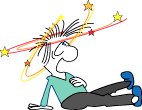|
Imagine
an egg, with its contents rocked back and forth after being
hit by an object not quite hard enough to break the shell.
Compare this to the human skull and you have concussion:
the result of a blow to the head or upper body that can
manifest in disorientation, loss of consciousness, and other
symptoms -
or nothing at all.
Undiagnosed danger is the alarm sounded in
a study by the University of Pittsburgh Medical Center (UPMC).
Recent guidelines have suggested that high school athletes
with mild or grade 1 concussions, could be returned to play
if asymptomatic for 15 minutes, yet the study indicates
much longer-lasting repercussions and a measurable decline
in neuropsychological functioning from such injury during
the first week of recovery.
 Forty-three male and female high school athletes
(a subgroup of 64 overall) tested with the "ImPACT" tool
for neuropsychological performance prior to respective playing
seasons; each was later tested two times during the first
week of recovery. ImPACT, developed by UMPC researchers,
includes assessment of attention, memory, reaction time
and information-processing speed. It is also used by the
NFL, NHL, MLB, several athletic organizations and approximately
250 high schools in the United States. Forty-three male and female high school athletes
(a subgroup of 64 overall) tested with the "ImPACT" tool
for neuropsychological performance prior to respective playing
seasons; each was later tested two times during the first
week of recovery. ImPACT, developed by UMPC researchers,
includes assessment of attention, memory, reaction time
and information-processing speed. It is also used by the
NFL, NHL, MLB, several athletic organizations and approximately
250 high schools in the United States.
A dramatic decrease in memory and an increase
in self-reported symptoms was visible in mildly concussed
athletes 36 hours after an injury. The group with on-the-field
symptoms lasting longer than five minutes retained a 500
percent chance of demonstrating a drop in memory performance.
The study also pointed out the 1.25 million
high-school-age contact-sport athletes who incur an estimated
63,000 concussions per year, with mild concussion occurring
most frequently. Research suggests - or rather, demands
- that this type of injury be looked at more carefully.
No longer should the words, "I'm fine," be acceptable to
parents and school officials when coming from a "mildly
concussed" high school athlete.
Reference:
Lovell MR, Collins MW, Iverson GL, Johnston KM, Bradley JP.
Grade 1 or "ding" concussions in high school athletes. American
Journal of Sports Medicine 2004:32, pp47-54.
For more information on sports and fitness, visit www.chiroweb.com/find/archives/sports/index.html
|



